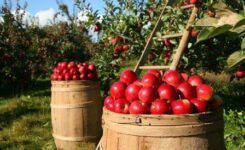Nurseries: We have different types of nurseries and they are vegetable nurseries, tree nurseries, grafting nurseries and layering nurseries. The types of nurseries are well explained below.
Table of Contents
Categories of nurseries:
Vegetable Nursery:
- They are used for raising the seedlings of vegetable crops.
- Tomatoes, cabbages, kale, onions, brinials and peppers.
Vegetable Propagation Nurseries:
- They are used for inducing root production in cuttings before they are transplanted,
- The cuttings can be planted directly in the soil and hence called bare root nurseries.
- Or planted into containers such as pots, polythene bags and others, hence called containerized nurseries.
Tree Nurseries:
- These are used for raising tree seedlings.
- The seedlings can be raised in bare root nurseries or in containerized nurseries.
Nursery Management Practices:
These are the practices carried out in the nursery while the planting materials are growing.
They include:
- Mulching; —light mulch should be applied on the nursery bed. lt be should be removed on the 4 day
- Weed control.
- Pricking out.
- Pests and disease control.
- Hardening off
Preparation of vegetative materials for planting:
Cuttings -These are plant parts such as stems, leaves and roots induced to produce roots and used as planting materials.
Grafting –
- It is the practice of uniting two separate woody stems.
- The part bearing the roots are referred to as root stock while the part which is grafted onto the root stock is known as scion.
- The scion has buds which develop into the future plant.
- The ability of the root stock and the scion to form a successful union is termed as compatibility.
Methods of Grafting
Whip or tongue grafting:
- In this case the diameter of the rootstock and the scion are the same.
- It is carried out when the diameter of the scion and the rootstock is ‘pencil’ thick.
Side grafting:
In this case the diameter of the rootstock is bigger than that of the scion.
Other types of grafting include:
- Approach rafting,
- Notch grafiing
- Bark grafting.
Budding:
- It is the practice of uniting a vegetative bud to a seedling of another plant.
- The scion has only one bud and some bark with or without wood.
- The bud is inserted in a slit made on the bark of the stock.
- It is held tightly on the stock by tying with a budding tape until it produces a shoot.
Methods of Budding:
- T-budding Top
- budding Patch
Importance of Budding and Grafting:
- Plants with desirable root characteristics but with undesirable products may be used to produce desirable products for example lemon-orange graft.
- They facilitate the changing of the top of the tree from being undesirable to desirable
- They make it possible to grow more than one type of fruit or flower on the same plant.
- They help to propagate clones that cannot be propagated in any other way.
- They help to shorten the maturity period.

Layering
- It is the process by which a part of a plant is induced to produce roots while still attached to the mother plant.
- Once the roots have been produced, the stem is then cut off and planted.
Types of layering;
- Marcotting or aerial layering.
- Tip layering.
- Trench layering.
- Compound or serpentine.
Tissue Culture for Crop Propagation
- Tissue culture is a biotechnology used in cloning vegetative propagated plants.
- It is based on the ability of plant tissue (or cells) to regenerate other parts of the plant.
- The tissues are derived from shoot tips where cells are undergoing rapid cell division and are not differentiated.
- The cells are then provided with the right conditions which enable them to multiply and develop roots.
The Right Conditions for tissue culture:
- Culture medium.
- Correct temperature.
- Correct light intensity and
- Correct relative humidity.
Importance of Tissue Culture in Crop Propagation
- It is used to recover and establish pathogen-free plants especially in the control of viral diseases.
- It is used in mass production of plantlets or propagules.
- It is fast and requires less space than the cultural methods of using cutting which requires a bigger space.
Transplanting Seedlings
- Transplanting of vegetable and tree seedlings are generally the same.
- Generally, vegetable seedlings are ready for transplanting when they are one month old or have 4 -6 leaves or are about 10-15cm in height.
- Before transplanting, the nursery bed is adequately watered 3 – 4 hours before lifting the seedlings.
- This ensures the seedlings are lifted easily with a ball of earth around the roots to minimize root damage.
- Tree seedlings take a little longer to reach transplanting age compared to vegetable crop seedlings.
- The roots are trimmed before lifting the seedlings.
- Transplanting should be done at the onset of the long rains to give the young trees a good start.
After transplanting the young trees should be protected from damage by animals for a period of about one year.
See also
CLASSIFICATION OF ANIMAL FEEDS